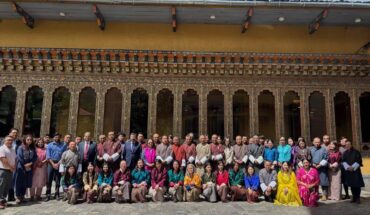
NGAWANG JAMPHEL | Thimphu
The Royal Civil Service Commission (RCSC) Annual Report 2024–2025 has revealed that the civil service strength stands at 30,025, showing a near recovery to pre-attrition levels despite consecutive years of high separation rates.
Of the total, 17,635 are men while 12,390 are women, representing 59.73 percent and 41.26 percent respectively.
The report highlights that the overall civil service-to-population ratio currently stands at 1:26, with the median age of civil servants recorded at 36 years.
During the financial year 2024–2025, a total of 2,880 new recruits joined the service, while 2,377 employees left through separation.
Over the past five years, recruitment trends have fluctuated, peaking in 2022–2023 with 3,244 recruits before dropping to 1,406 in 2023–2024, and then rising again to 2,326 this year.
The separation figures remain a concern, given that attrition rates in recent years were significantly high—8.62 percent in 2022 and 16 percent in 2023.
The civil service remains heavily concentrated in a few key sectors. Education Service accounts for the largest share with 38.9 percent of the workforce, followed closely by Technical Service at 37.8 percent.
Administration Service makes up 16.9 percent, while Finance Service constitutes 5.2 percent.
The report also breaks down recruitment categories: 49.2 percent of new recruits were placed under the Professional and Management Category (PMC), 42.2 percent in the Supervisory and Support Category (SSC), 7.5 percent in the Operational Category (OC), and 1.1 percent in the Executive and Specialist Category (ESC).
Regular employees dominate the civil service, making up 81 percent of the total strength, while 19 percent serve on contract.
Although men continue to outnumber women, the 41.26 percent female representation indicates gradual progress toward gender balance within the civil service.
The RCSC has in recent years emphasized inclusivity and gender equality, though challenges remain in ensuring higher representation of women at leadership and decision-making levels.
The Annual Report 2024–2025 stresses the importance of aligning civil service priorities with the broader national development vision, particularly the move toward an “Entrepreneurial Bureaucracy (E2B)” aimed at enhancing productivity tenfold over the next decade.
To effectively realize this goal, the RCSC underscores the need for addressing attrition, ensuring balanced recruitment, and building stronger retention strategies.
A key focus will also be enhancing efficiency through digitalization and human resource development initiatives.
In the way forward the RCSC had review the mandatory bell curve, particularly to eliminate or remove the category of the Partially Meeting Expectation.
The forced bell curve was introduced from the fiscal year 2015-2016 onwards with the goal to raise the performance standard fitting ‘excellence in service.’
RCSC said the removal of the forced quota, especially the Partially Meeting Expectations (PME) category, risks reversing the progress made in civil service performance, minimal accountability and the entrenched ‘iron rice bowl’ mentality.
“The success of the Civil Service Reforms (2021-2023) should be measured not by the structures and names of the agencies but by the sustained higher work performance standards and accountability. Performance differentiation is vital for staff motivation and talent management,” the report states.
The second way forward is transitioning the Bhutanese civil service to a corporate culture which continues to remain a challenge.
The report states that the civil service has long operated within a hierarchical, process-oriented framework where compliance and procedural correctness take precedence over agility and measurable results.
“While structured performance systems and accountability mechanisms are being introduced, shifting entrenched mindsets, work habits, and bureaucratic processes towards results-driven, agile practices requires sustained effort, leadership commitment, and cultural change at all levels,” it states.
To ensure the success of the current Civil Service transformation, the report underlines to institute corporate governance, it is essential to grow a new breed of entrepreneurial, forward-leaning bureaucracy.
The Commission also underscores the urgency of investing in high-impact leadership supported by an ecosystem of structures and leadership talent management systems to optimize the talent and potential of the leadership team.
Meanwhile, the report states that the Commission recognizes the “transformative potential of AI” and the urgency to seize the growth opportunities by embracing AI to enhance efficiency, improve citizen experience, and accelerate workflows by automating routine tasks.
To achieve this, the Commission urges that AI adoption must be systematic and supported by training, clear ethical guidelines, and strong leadership commitment.
A survey on the use of AI in the Civil Service suggests that civil servants use AI in some form based on an individual’s interest, like desk research, reasoning, and drafting using open sources. However, the depth of AI integration in the work process is limited at the moment.
Therefore, to support the AI users and deal with the perceived complexity of AI and ethical use, the Commission, in collaboration with the GovTech Agency, launched ‘the Generative AI Guidelines for Use in Civil Service
As part of the broader strategy to address civil service attrition and strengthen workforce stability, the RCSC undertook a comprehensive review of the Pension Rules and Regulations 2022, particularly in light of rising voluntary resignations among midcareer professionals.
Between January 2021 and August 2024, a total of 1,140 civil servants who had served between 15 to 20 years voluntarily resigned.
These mid-career exits were particularly acute in critical service areas such as Education & Training (373), Medical & Health (36), Architectural and Engineering Services (111), Finance & Audit (95), and Agriculture & Forestry (158).
Many of these resignations were driven by the incentive to access lump sum pension or provident fund benefits after 20 years of service.
The report outline that the recruitment and talent acquisition in the civil service are still traditional, and career-based civil servants are recruited through competitive civil service examinations.
“This method of talent management is now challenged on many fronts post 2023, when the Civil Service saw 16% attrition. While the attrition has settled to around 5% at an aggregate level, loss of talent in critical professions like the ICT, engineering, and health continue adding to the number of talent shortages,” the report stated.
The report further states that the Civil Service needs to proactively transition from the traditional bureaucracy to one that of an “Enlightened Entrepreneurial Bureaucracy.”
“To answer this call, the Civil Service must be equipped with discipline, ready to challenge the status quo, break through limitations, and embrace relentless changes. Overcoming these challenges and measuring our progress should be the driving force behind our new operating system,” it states.





